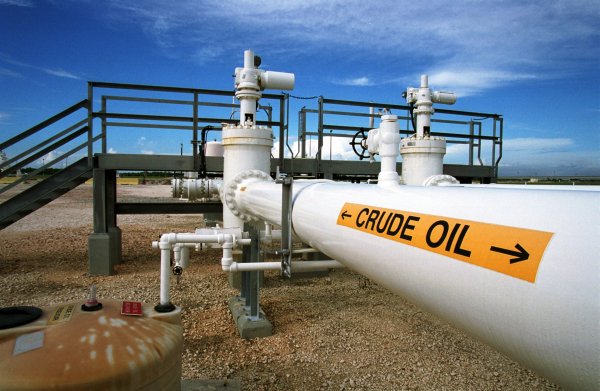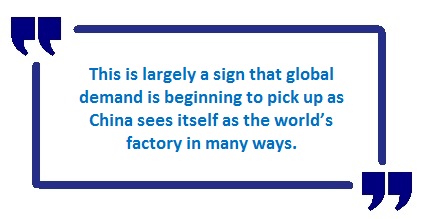Macro-Economic Appeared Better Than Expected
By Anthony Lawry
 China's macro-economic picture appeared better than expected for the month of March with trade data coming in slightly higher in conjunction with President Trump softening his tone against the world's second largest economy.
China's macro-economic picture appeared better than expected for the month of March with trade data coming in slightly higher in conjunction with President Trump softening his tone against the world's second largest economy.
China's exports for the month of March grew at their fastest rate in more than two years for the month elevating itself to 16.4 percent from 2016's export figures. This is largely a sign that global demand is beginning to pick up as China sees itself as the world's factory in many ways. Furthermore, import growth remained at a relatively high level at 20.3 percent driven by higher consumption in oil, cooper, coal, soybeans and iron ore which were all commodities that saw volumes of consumption surge from February in spite of concerns over rising supply. Also, crude oil imports saw a record high.
All of this came on the heels of US President Donald Trump softening his tone on previously made threats regarding a 45 percent blanket tariff on all Chinese goods imported into the US. While he initially stepped away from 45 percent to a more modest 10 percent blanket tariff increase, Trump told reporters that he would not declare China a currency manipulator after the meeting with Chinese President Xi Jinping at the 'Southern Whitehouse' in Trump's Mar-a-Lago resort in Florida. He then signaled to reporters that the blanket ban would be dropped altogether with more targeted tariffs on Chinese commodities which are charged for being 'dumped' into the US market at astoundingly low rates. Nonetheless, the political risk between the US and China on trade war is becoming more and more remote as leaders between the two countries begin to show a reluctance for economic conflict.
 Regardless of alleviation of these particular economic conflicts, President Trump has yet to back off from his comments during the campaign wherein he railed against the US's trade deficit with China. Despite this, exports to the US grew by 19.7 percent year from a year earlier with the trade surplus coming down slightly from $50.57 billion USD to $49.6 billion USD from a year ago.
Regardless of alleviation of these particular economic conflicts, President Trump has yet to back off from his comments during the campaign wherein he railed against the US's trade deficit with China. Despite this, exports to the US grew by 19.7 percent year from a year earlier with the trade surplus coming down slightly from $50.57 billion USD to $49.6 billion USD from a year ago.
Other statistics pointed towards a better economy than expected as well. Trade surplus was reported at $23.9 billion in March while analysts were expecting it to return to $10 billion which came on the heels of China reporting its first trade gap in three years. This is largely a result of central authorities attempting to shift China's economy towards more consumption over exports which now seems to be working despite the low levels of development in provinces further away from coastal regions and in the rural sections of the country. Despite this, officials are still keeping an eye on the country's trading situation as the customs office expressed its disposition on the complicated nature of international trade and how challenges to trading nations like China are still tangible in the short-term.
State-run Xinhua news agency was also eager to mention the numerous positive economic data which it has been observing over the past month. This included the growth in the sales of excavators in March which increased by 55 percent, an increase by 99 percent from the previous year. Also, the entrepreneur confidence index increased to 61.5 from 54.1 from the previous quarter, a positive sign that business leaders are much more positive about the overall economic outlook for the country.
 US investment and banking giant Goldman Sachs also came out with a report suggesting that economic growth would be at 6.8 percent for the year, an additional positive note confirming that outside China observers are also confident in the economic outlook of China for 2017. This comes on the heels of gross domestic product adjustment that was lowered by central authorities to 6.5 percent. In 2016 the economy expanded to 6.7 percent so the 6.8 percent figure introduced by Goldman Sachs comes as a much better forecast considering the downgrade and expectations for lower growth.
US investment and banking giant Goldman Sachs also came out with a report suggesting that economic growth would be at 6.8 percent for the year, an additional positive note confirming that outside China observers are also confident in the economic outlook of China for 2017. This comes on the heels of gross domestic product adjustment that was lowered by central authorities to 6.5 percent. In 2016 the economy expanded to 6.7 percent so the 6.8 percent figure introduced by Goldman Sachs comes as a much better forecast considering the downgrade and expectations for lower growth.
Bloomberg also points out several indicators of positive growth. The SpaceKnow China Satellite Manufacturing Index pointed to a higher output of manufacturing growth in the country rising from 51.1 to 51.8. A reading of 50 or higher indicates positive manufacturing growth in the country. This index is also highly correlated with China's manufacturing PMI data which now rests at a level of 51.5.
 Smaller businesses are also seeing a surge in growth. Standard Chartered Plc's Small and Medium Enterprise Confidence Index rose to a level of 60 this month, its highest level in nearly two years. The index tracks profitability, sales and production which all rose in small Chinese companies for the month gone by.
Smaller businesses are also seeing a surge in growth. Standard Chartered Plc's Small and Medium Enterprise Confidence Index rose to a level of 60 this month, its highest level in nearly two years. The index tracks profitability, sales and production which all rose in small Chinese companies for the month gone by.
Overall, the amount of positive economic data for the month was much greater than the negative economic data which has consistently been the amount of provincial and state-owned enterprise debt in conjunction with a heated property market and subpar equity markets. Regardless, with the rise of global growth, it appears that China may be on the verge of having a better year than anticipated despite the end of 2016 negative outlooks.
--- END ---